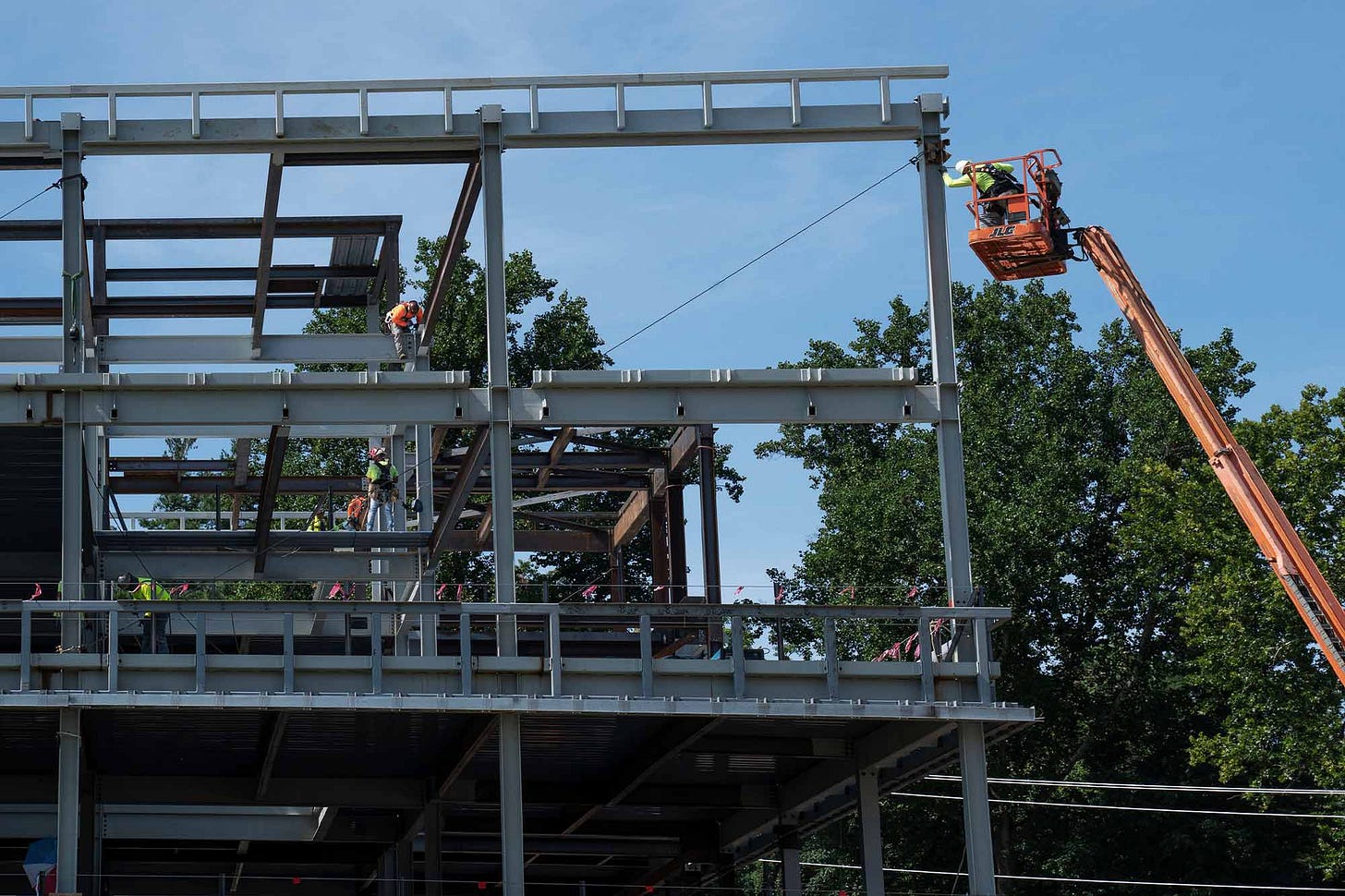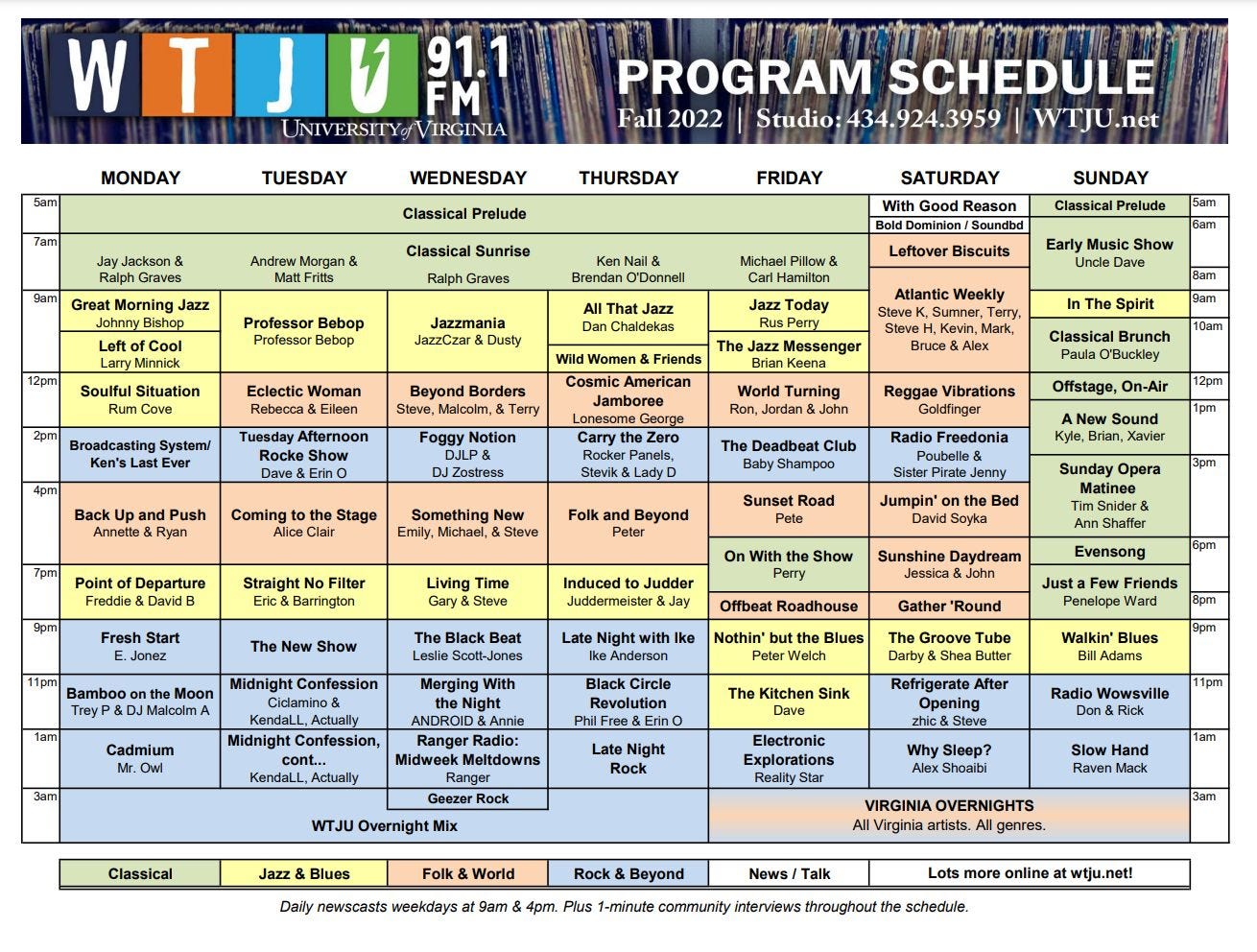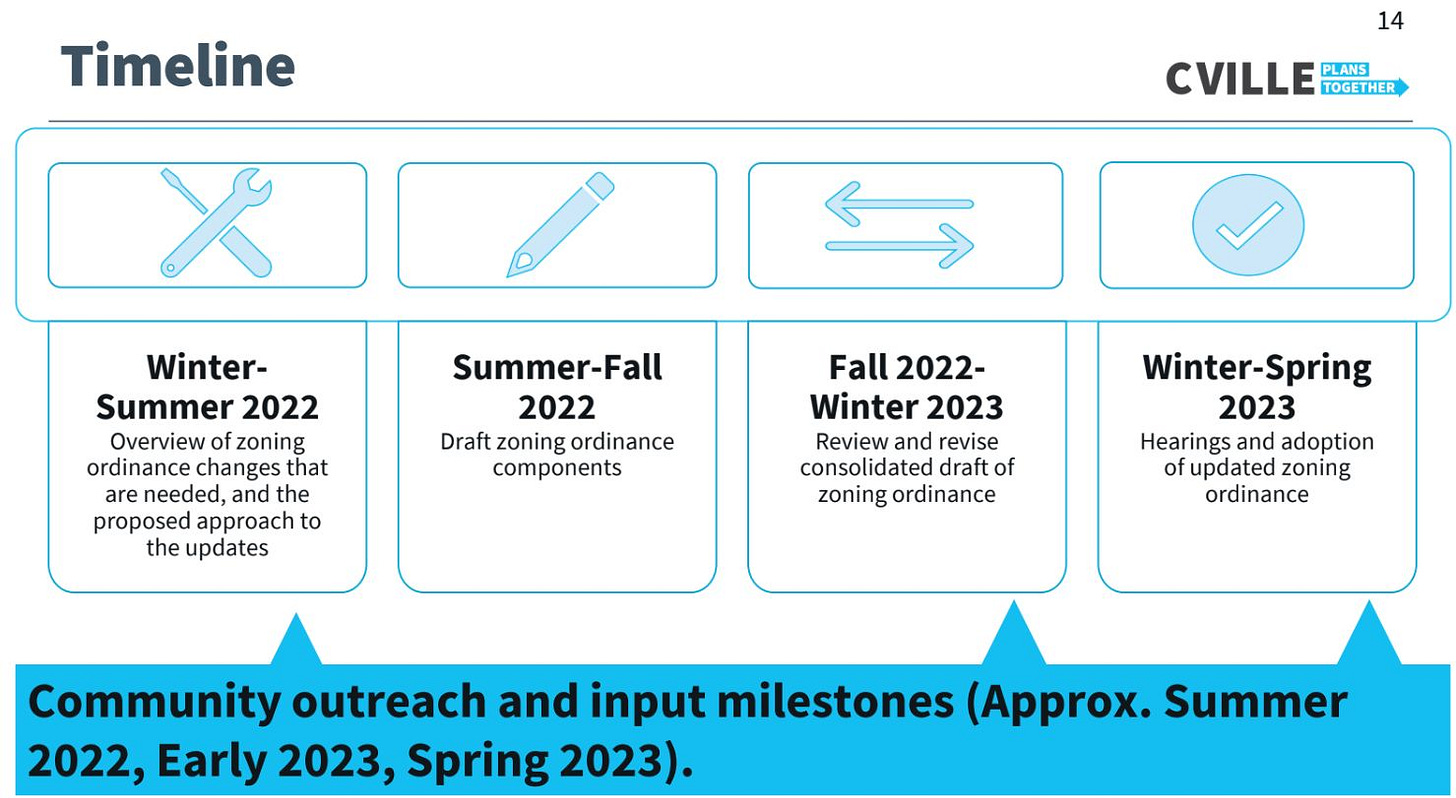How did we find ourselves to be halfway through the month? By living on a planet that spins around on its axis at roughly 1,000 miles per hour, 365 times as it makes its way around a yellow star in the unfashionable end of the western spiral arm of a galaxy that likely has no inkling that it is being invoked in the introduction to the next edition of Charlottesville Community Engagement!
I’m Sean Tubbs, back from a small break in the space-time continuum fueled with energy.
On today’s show:
The final beam is placed atop the new School of Data Science at the University of Virginia
Charlottesville’s Economic Development Office seeks a consultant to help with a five-year strategic plan, and opens up a new round of BRACE funding for businesses
Preservation Piedmont is seeking proposals to pay for research into historic buildings
Review continues of the way that Charlottesville will rewrite its zoning ordinance
First shout-out: Save the date for Rivanna Conservation Alliance’s Community Watershed clean-up
In today’s first Patreon-fueled shout-out: Mark your calendar for the Rivanna Conversation Alliance’s third annual Rivanna River Round-Up community watershed cleanup coming up on Saturday, September 24. The RCA organized the first round-up in September 2020 as a safe way for the community to give back to the river during the COVID-19 pandemic. Over the last two years, a total of 245 volunteers have cleaned up 67 miles of streams, nearby trails and the Rivanna River, removing 192 tires and 213 large bags of trash from the waterways. Details will soon be made available and you can get those by signing up for the Rivanna Conservation Alliance newsletter at rivannariver.org.
Milestone reached for UVA School of Data Science building
The Emmet-Ivy corridor being developed by the University of Virginia continues to transform with major infrastructure being placed underground to support a number of major new buildings.
One of those new structures is the School of Data Science, which is to be a four-story building facing Emmet Street with a green roof. The final steel beam was placed atop the exoskeleton in a ceremony on August 2, according to an article in U.Va Today.
Over 300 construction workers, data science students and others involved at UVA signed the final beam, which was hoisted into the air along with an artificial Christmas Tree.
The occasion was marked by the University of Virginia Architect who said a new era has begun for area land use.
“This building for the School of Data Science will serve as a ‘front door’ for the district, and therefore this day not only marks an important milestone in the construction of a single building, but also marks the beginning of the realization of a vision for this new and exciting district for the University,” said Alice Raucher.
Those working on the project include Gilbane Construction, Liphart Steel, Virginia Steel Erectors Inc., Piedmont Concrete Contractors Inc., Design Electric Inc., Riddleberger Brothers Inc. and Faulconer Construction Company.
On the design team are VMDO Architects, Hopkins Architects and Arup engineers.

Charlottesville seeking consultant to work on economic development strategic plan, offers new BRACE funding for businesses
What direction should economic development go in the city of Charlottesville? The city is seeking a firm to help create a new strategic plan to guide the next five years. A request for proposals was issued in late July that seeks the following:
A full review and analysis of key demographic information and relevant economic indicators for the City, presented in context with at least 10 peer cities.
An analysis of existing target industry clusters and their associated workforce.
A review and deep understanding of the City’s current situation with regard to opportunities and constraints with attention to:
a) current/planned land use and zoning rules
b) national/regional trends in real estate development
c) trends in entrepreneurship and business development
The work will also require a stakeholder engagement strategy as well as a five-year plan with goals that reflect stakeholder input. The request for proposals closes on August 29.
According to the city’s website, “the Office of Economic Development is the catalyst for public and private initiatives that create employment opportunities and a vibrant and sustainable economy.”
Today the Office of Economic Development has announced another round of grants under the Building Resiliency Among Charlottesville Entrepreneurs (BRACE) program.
New recipients can receive up to $2,500 for business promotion, modifications to business models, property improvements, and to cover costs associated with the COVID-19 pandemic. Previous recipients can obtain up to $1,250. Businesses have to make a 30 percent match.
Applications will be taken through September 15 and expenses have to have been incurred between May 1 and September 2. (apply for the grant)
Preservation Piedmont seeking applications for funding
An area nonprofit that seeks to draw attention to historic buildings and advocates for their preservation is seeking applicants for grants. Preservation Piedmont is offering up to $3,000 in funding for research, documentation, interpretation, and articles about historic places.
“Proposals will be considered from individuals, organizations, and/or localities from the following: City of Charlottesville and the counties of Albemarle, Buckingham, Fluvanna, Greene, Louisa, Madison, Nelson, and Orange,” reads a section of the Preservation Piedmont website.
Preservation Piedmont began its grant program in 2008. Here are some recent recipients:
The Albemarle Charlottesville Historical Society - Hatton Ferry $2,000 | December 2021
Burley Varsity Club - publication of Unforgettable Jackson P. Burley High School $1,000 | December 2021
Friends of Gladstone Depot - to repurpose the depot as a community center in Nelson County $3,000 | December 2021
Woolen Mills Chapel Foundation - bell chapel stabilization, $1,500 | November 2020
Rose Hill Baptist Church - cemetery restoration efforts, $1,500 | November 2020
Friends of Esmont - book on history of Esmont village, $3,500 | November 2020
Jackson P. Burley Varsity Club – book on history of high school, $1,000 | June 2020
Louisa County Historical Society – porch painting project $1,000 | August 2019
Virginia Organizing / B.F. Yancey Heritage and History Committee – history project and exhibit, $1,000 | November 2018
Albemarle Blue Ridge Heritage Project – signage, $1,000 | June 2017
This grant cycle closes on September 23 so get the word out to those you think may be interested.
Second shout-out: WTJU adjusts nighttime programming
In today’s second Patreon-fueled shout-out, WTJU 91.1 FM wants you to know about upcoming changes to its programming schedule. There’s a lot to love about WTJU’s programming, but from time to time, the station needs to adjust to better serve our community. WTJU’s strategic framework prioritizes better representation of the diverse demographics of our community – both in the on-air talent and the audience. Here are some of the changes:
Monday-Thursday evening classical shows will mostly move to Sundays, which will air classical music almost the entire day.
Monday-Thursday evening jazz shows will move up two hours, from 9 – 11 p.m. to 7 – 9 p.m.
Monday-Thursday evenings 9 – 11 p.m. will air four new shows featuring hip-hop, soul, R&B, funk, and more.
For the full list of the changes that go into effect August 29, visit wtju.net.
Review of zoning rewrite continues in Charlottesville
Earlier this month I asked if this was the summer of AC44, as Albemarle County’s review of its Comprehensive Plan has been called. Compared to a similar effort in Charlottesville, AC44 is in its infancy being at just halfway through the first phase, which is taking a look at the county’s longstanding efforts to preserve rural area land from overdevelopment through growth management.
We’re now well into the third year of the Cville Plans Together initiative, with both an Affordable Housing Plan and an updated Comprehensive Plan calling for a significant increase in residential density.
At their meeting on August 9, the Charlottesville Planning Commission and Charlottesville City Council got an update on the creation of a Zoning Diagnostic and Approach report intended to inform the new zoning rules that will make it easier for bigger buildings on almost all parcels of land across the city.
“Zoning is that set of regulations and tools that define the buildings that can be built, the building spaces as opposed to open space, and then how land can be used,” said James Freas, the city’s director of Neighborhood Development Services.
Freas said the zoning rewrite offers the opportunity to address problems that have built up over time in the zoning code. One example over the years has been the way height is calculated as there are many conflicts. Freas said the rewrite is intended to make the city’s zoning rules easier to read.
“We want a zoning ordinance that someone can readily refer to and understand what they can do with their property, or what could possibly happen in their neighborhood and at the end of the street,” Freas said.
Freas said the rewrite could also include further changes to the Future Land Use Map adopted as part of the Comprehensive Plan. That document suggests increases in density on every residential parcel, intensity depending on the color of the map.
“When we talk about implementing the Comprehensive Plan, we’re talking about implementing the vision of the Comprehensive Plan,” Freas said. “We’re talking about affordable housing as we have been throughout this hole process. Addressing inequities. Walkable, people-focused. Protecting the natural environment and then significantly, working with our existing urban design and historic preservation in pursuit of all of these other goals.”
Other words and phrases Freas highlighted are climate change, context-sensitive design, reducing approval times.
“These are all kinds of key words from the strategies that make up the land use chapter and all things that ought to be reflected in the zoning ordinance as we move forward,” Freas said.
Eventually there will be a toolkit created to avoid displacement of existing landowners in at-risk communities identified as “Sensitive Communities” in the Future Land Use Map. Freas said he had to make one clarification.
“When we talk about preventing displacement as construing that as somehow protecting these vulnerable communities from change and that is not what we’re talking about. There will be opportunities for redevelopment in those communities but the idea is how do we protect the people who live within that neighborhood from displacement. To put it another way, how do we create opportunities for the people who live in that neighborhood to continue to live in that neighborhood. We know and our experiencing that gentrification is what happens when people are pushed out. They no longer can afford to live within the community. And that’s the issue that we’re trying to address.”
This week will see the publication of a draft inclusionary zoning program intended to tie density to affordability, as well as a model of how the market may react to an increase in allowable density.
“The rules of thumb as we move into this?” We’re seeking the greatest level of affordability that is market viable,” Freas said. “We’re aiming for sixty percent of [Area Median Income]. That’s what we want to get to. We have to see what the market can support.”
One programming note. My summary of Charlottesville property transactions in July should be posted some time this week. That will go to paid subscribers first, but you’ll be able to see this 19th installment of this endeavor on Information Charlottesville.

The zoning approach recommends that the available building space depend on the characteristics of a particular lot including frontage, size, acreage. Other changes will include reducing the number of parking required in new developments.
In the public comment before the discussion, Former Commissioner Genevieve Keller noted that the draft approach calls for the elimination of the Planning Commission in granting critical slopes waivers and design approvals for projects in the city’s official entrance corridors. She said she appreciated the desire to streamline the process by having staff make the final call.
“But I also think there is a role for the public and sometimes the entrance corridor or the slopes is the only way the public gets to know about a project and so I would ask you to try to think of ways to keep the public involved,” Keller said. “I don’t know if that means putting it on the consent agenda or having a small committee of two of you that are working with staff.”
Commissioner Hosea Mitchell shared the concern about turning over final approval to staff in aesthetic situations.
“I worry that if we begin leaning towards black and white we lose some of the aesthetic concerns that the architects suggest that we ought to have,” Mitchell said.
Commissioner Jody Lahendro said he was concerned that planning staff are already overworked and may not have the time to conduct a thorough review. He said he’s spent time in the past two years reviewing site plans as a member of the Tree Commission.
“Things were being missed and just handled administratively and then finding out there were problems later on,” Lahendro said. “I am looking for transparency and I want there to be transparency and the opportunity to question the decision made by staff.”
Some Commissioners suggested simply transferring the duties of the Entrance Corridor Review Board to the Board of Architectural Review.
As for critical slopes, Freas said that change is more about timing. Currently the Planning Commission is asked to make a determination on waivers at the same time a rezoning is considered. That is often before detailed site work has begun.
“We all inherently recognize the value of protecting critical slopes,” Freas said. “That’s not what’s at issue here. It’s really just at what stage of the development process does it make sense to do this review.”
The Commission also had a long discussion about height. Commission Chair Lyle Solla-Yales said he feels the city needs to allow as much as possible in new buildings.
“Height of course is a huge issue in terms of aesthetics as well as affordability,” Solla-Yates said. “If you want to raise prices, reduce height. It’s extremely powerful. I’m concerned about the friction between our affordable housing goals and any additional height regulations.”
Public comment will be taken through the end of the month, including in an online survey. NDS staff are meeting with various neighborhood groups to gather comment from members of the community. The draft report will be updated to take all of that feedback into account. Freas said the goal is to release at least a portion of a draft zoning code to the public in early 2023 with adoption later that year.
“We are aiming for spring of 2023,” Freas said. “I will note that spring runs all the way until June 21.”
For the full discussion take a look at the video on the city’s streaming video archive. I may have more on from this meeting in a future installment of this program. There was a discussion of parking requirements and that will take its own segment.

Housekeeping notes for episode #417
This is the first episode back after a break in which I visited a different place and experienced life without a deadline for an entire week. That also means I’ve not had the chance to go through several government meetings. So, this week and into next, there will be several segments from earlier meetings.
One of them will be from the meeting of the Charlottesville Tree Commission from August 2. There was a presentation from Tim Beatley, a professor in the Department of Urban and Environmental Planning at the University of Virginia. Outgoing Charlottesvillle Planning Commissioner Jody Lahendro was there.
“He gave a very good presentation on innovative tree conservation in cities,” Lahendro said. “Existing mature trees are exponentially more important to the environment and human health than replacing them with new trees. Several U.S. cities have ordinances that allow relief from zoning requirements to preserve existing trees.”
We’ll hear more about this week in an episode of Charlottesville Community Engagement. My time away has provided fuel for me to get to that segment as well as many others as I get back to the work.
All of this is made possible thanks to readers and listeners. If you’ve not heard the podcast, I encourage you to do so as I feel it’s important to hear the voices of the people you read about from time to time.
So, if you’re like to support this program, consider a paid subscription through Substack. If you do so, Ting will match your initial payment! And, if you sign up for their services through this link you’ll get a free standard install, your 2nd month free, and a $75 downtown mall gift card! Enter the promo code COMMUNITY for full effect.
Music comes from the D.C. entity that currently goes by the name Wraki, You can support their work by purchasing the album Regret Everything for whatever you would like to pay.


















Share this post